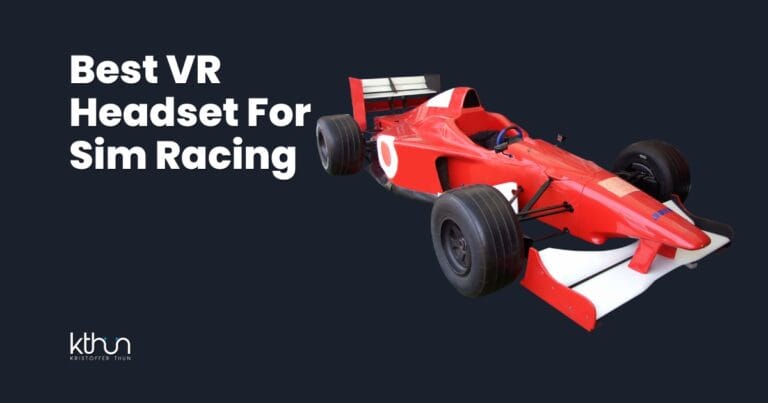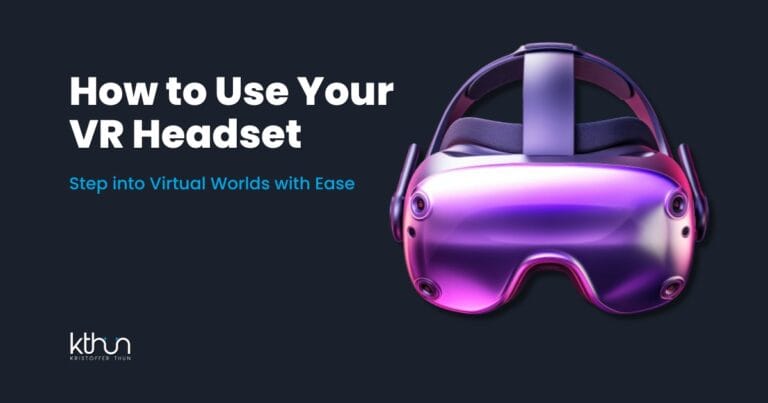What is PCVR (PC-based virtual reality), and how does it differ from standalone VR? Let’s dive in and unravel the magic behind these virtual realms.
What if you’re after an experience that goes beyond the ordinary?
That’s where PCVR steps in, harnessing the raw power of your trusty computer to whisk you away into a world of stunning graphics.
Can both be combined?
Yes, we will find out.
Let’s find out together!
I partner with awesome companies that offer products that help my readers achieve their goals! If you purchase through my partner links, I get paid for the referral at no additional cost! For more information, visit my disclosure page.
Key Takeaways
PC Virtual Reality (PCVR) uses a high-performance computer to deliver immersive experiences with high-quality graphics.
Cutting-edge VR hardware like Valve Index, HTC Vive Focus, and Meta Quest offer superior tracking, controller precision, and visual fidelity, creating deeply immersive experiences.
Standalone VR headsets offer portability without cables, while hybrid models like Pimax Crystal offer both standalone and PCVR modes for a wider range of content.
What is PCVR?

PCVR requires a powerful computer to run the VR headset.
Unlike standalone VR headsets, PCVR headsets offer high-resolution visuals, advanced tracking, and access to a wide range of immersive games and apps.
So, look at your powerful gaming PC as the core of your VR experience in PCVR.
This powerhouse generates graphics and processes data, enabling the creation of a realistic and immersive VR world.
And the best part?
The possibilities are almost endless.
From battling intergalactic enemies to exploring the world’s wonders, a vast universe of PCVR content is waiting to be discovered, including various vr games.
The Heart of PCVR: Powerful Computers
Any PCVR setup hinges on a high-performance computer.
It is like an engine that drives your vehicle and takes you through the immersive areas of the VR universe.
A robust graphics card, advanced CPU, and ample RAM make your PC VR-ready, delivering the necessary frame rates for an immersive VR experience.
But what if you’re a tech wizard with a penchant for tinkering?
Well, you’re in for a treat!
Custom-building your own VR-ready PC allows you to push the limits of what’s possible, ensuring that your VR experiences are phenomenal.

Connecting Your World: Cables and Setup
To bridge the gap between your PC and your VR headset, you’ll need the right cables, such as a link cable and a proper setup.
Think of HDMI 1.3 video output and multiple USB ports as your spaceship’s fuel lines and control panels, which are essential for a smooth VR journey.
Installing a PCVR system can be expensive and a lot to think about.
Connecting a Meta Quest 3 to a PC, for instance, requires a specific cable or a virtual desktop app. But once your gear is connected and your settings tweaked, you’ll be ready to blast off into the VR world!
Don’t forget to secure your cable in the ceiling to avoid getting tangled in the cable and for a freer feeling.
Access to a Vast Virtual Universe
Do you want access to a vast variety of PC VR games?
Whether you’re a hardcore gamer seeking adrenaline-pumping action or a curious explorer eager to tour the world’s wonders, PCVR has you covered.
And thanks to the power of your PC’s graphics card, these experiences come to life with high-quality graphics that will leave you in awe.
The world of PC-based VR gaming offers a wider range of experiences compared to standalone headsets.
From rehearsing conference speeches to exploring iconic attractions, the possibilities in this virtual world are as limitless as the stars in the night sky.
Unveiling The Best PCVR Headsets

Let’s talk about the rock stars in the PCVR hardware scene.
Ever heard of the Valve Index 2?
This headset it’s a gateway to a visual wonderland, boasting a mind-blowing 2880 x 1600 resolution and a speedy 144Hz refresh rate. It’s like upgrading from standard to high-definition in terms of visual fluidity.
And then there’s the HTC Vive Pro, another player in the VR game, promising an immersive escape from reality.
But wait, the Meta Quest 3 enters the arena with a twist!
It’s not just a standalone wonder; slap on a cable, and voila – it transforms into a PCVR powerhouse, offering you the best of both worlds.
Examples of PCVR Headsets:
Valve Index 2
Meta Quest 3
HTC Vive Pro 2
Pimax
HP Reverb G2
Tracking Precision and Controllers
Now, let’s talk tracking and controllers, the maestros of your VR symphony.
PCVR takes the lead with precision tracking, like having a GPS in a high-speed spaceship. Imagine 6 Degrees of Freedom (6 DOF) – you’re not just watching, you’re living it.
Enter the Valve Index controllers, which is your ticket to full-blown virtual mastery.
With finger-tracking magic, it’s like your hands have a mind of their own! Meanwhile, the Meta Quest 3 and HP Reverb G2? They’re breaking the mold with inside-out tracking, simplifying setup like never before.
No external sensors, no hassle!
Visual Fidelity: Resolution and Graphics
Visual fidelity in PCVR (PC-based virtual reality) refers to the quality and clarity of graphics displayed in virtual reality experiences. Similar to a panoramic view of a mighty mountain.
Resolution settings and graphics quality greatly influence visual fidelity in PCVR.
Technologies like SGSR (Snapdragon Game Super Resolution) offer ways to enhance visual clarity and detail without compromising performance, providing users with a more immersive and visually appealing VR experience.
Standalone VR Headsets vs PCVR: A Side-by-Side Comparison

Standalone VR and PCVR are akin to two distinct systems, each boasting strengths and limitations.
Choosing the right standalone headset is crucial for an optimal VR experience.
The PCVR is for VR enthusiasts who want a more advanced experience.
Pros and Cons of PCVR
| The Good Stuff of PCVR | What to Watch Out For of PCVR |
|---|---|
Superior graphic capabilities due to the power of high-end PCs. | Requires a significant initial investment in a VR-ready PC. |
Access to a more extensive library of VR games and applications. | Less convenient due to the need for cables and a fixed play space. |
Higher display resolutions and better refresh rates for a more immersive experience. | Setup can be more complex and time-consuming. |
Advanced tracking and controller precision for enhanced interactivity. | Less portable than standalone VR headsets, limiting where you can use it. |
Potential for future upgrades and customization of PC components. | Ongoing maintenance and updates for the PC to ensure optimal performance. |
Wireless VR Experience

Imagine a cable-free VR experience allowing you to freely explore the virtual universe.
Wireless VR experiences offered by standalone headsets allow you to venture far and wide in VR, untethered from a space station.
The Meta Quest 3 provides a wireless VR experience by connecting to a PC through a Wi-Fi network.
This feature allows users to move freely, significantly enhancing the sense of immersion and overall user experience.
Moreover, with the introduction of the 5G standard, we can expect quicker device connectivity and ultra-low latency for real-time image transmission.
Power Meets Portability: Hybrid Solutions
Think That’s the beauty of hybrid VR solutions like the Pimax Crystal or Meta Quest 3 (Air Link or wired), which offer standalone and PCVR capabilities.
It’s like having the best of both worlds, providing users with operational flexibility.
Although the standalone mode of the Pimax Crystal is convenient for portability, it has a more limited range of games and applications.
However, when you use its PCVR capabilities, you can access a much wider range of content. It’s like having a starship that can transform into a rocket when you need more power.
Augmented Reality and PCVR: Blending Worlds

Alright, explorers, brace yourselves for the mind-bending fusion of realities!
Have you ever dreamt of seamlessly cruising through the virtual and real worlds in your VR adventures?
Hold tight because AR and PCVR are teaming up to make that dream a jaw-dropping reality.
Imagine it: effortlessly transitioning between the vastness of space and the familiarity of Earth.
That’s the magic of merging augmented reality (AR) with PCVR – a unique blend of experiences that’ll make your reality-shifting dreams come true!
Maximize Your VR Setup’s Performance

Now, let’s delve into the key steps for keeping your VR setup running at its absolute best.
Consider your VR rig as a finely tuned machine – regular maintenance is the name of the game.
Optimizing Your Setup for Peak Performance:
Keep your operating system and graphics card drivers up to date with the latest tools for optimal performance.
Regularly clean out your PC case to prevent dust and hair build-up, ensuring your VR setup remains sleek and efficient.
Consider defragmenting your hard disk drive (HDD) or enabling TRIM on a solid-state drive (SSD) for improved data access speeds and overall system performance.
Tweak graphics card settings, adjust virtual memory, or set the power plan to high performance for a top-notch VR experience.
Remember, it’s like adjusting settings on your favorite gadget – proceed with care to avoid hiccups.
The Future of PCVR: Trends and Predictions
Looking into the future of PCVR, we can expect:
Advancements in digital infrastructure, like 5G and 6G networks, will provide higher bandwidth, lower latency, and more reliable connections.
Enhanced VR experiences with improved graphics, resolution, and frame rates.
More immersive gameplay with haptic feedback and advanced motion tracking technology.
Integration of AI and machine learning to create more realistic and intelligent virtual environments.
Growth of VR applications beyond gaming, including education, healthcare, and virtual tourism.
These exciting possibilities and unexplored territories are just the beginning of what PCVR offers.
Cloud-based VR could make VR more accessible by offloading processing tasks to remote servers, potentially lowering the cost of entry.
With tech giants like Apple, Samsung, Google, and Qualcomm entering the fray, we can expect the emergence of new mixed-reality headsets, possibly offering new ways to blend AR and VR technology.
That’s a Wrap
Embarking on the VR adventure, PCVR and standalone VR each bring their magic.
PCVR’s raw power or the nimble flexibility of standalone VR – your choice depends on your VR dreams.
The VR world holds future wonders, from blending augmented reality with PCVR to cutting-edge hybrid solutions.
Strap on your VR headset, ignite those engines, and dive into the boundless universe of VR!
Frequently Asked Questions
What does PCVR mean?
PCVR means PC Virtual Reality, where a powerful computer renders the VR experience, making the VR headset act like a monitor.
Is Quest 2 a PCVR?
You can easily set up PCVR on your Quest 2 using Oculus Link, Air Link, or Virtual Desktop to enjoy a wide range of PC VR games.
How much does a PCVR cost?
PCVR systems can cost anywhere from $399 for a Meta Quest to $1,599 for a Vive PRO (2019). Prices vary depending on the brand and model.
What are the system requirements for a PCVR setup?
You will need a VR-ready PC with at least an Intel i5-4590 or AMD Ryzen 5 1500X processor, 8GB of RAM, a DirectX 12 compatible graphics card like the NVIDIA GTX 1060 or AMD RX 480, HDMI 1.3 video output, and USB 3.0 ports. Ideally, make sure your PC meets or exceeds these requirements.
What is a hybrid VR solution?
A hybrid VR solution, such as the Pimax Crystal or Meta Quest 3, combines standalone and PCVR capabilities, offering both portability and the power of PCVR when necessary.






